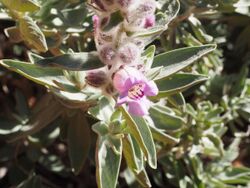Biology:Pityrodia
| Pityrodia | |
|---|---|

| |
| Pityrodia augustensis | |
| Scientific classification | |
| Kingdom: | Plantae |
| Clade: | Tracheophytes |
| Clade: | Angiosperms |
| Clade: | Eudicots |
| Clade: | Asterids |
| Order: | Lamiales |
| Family: | Lamiaceae |
| Subfamily: | Prostantheroideae |
| Genus: | Pityrodia R.Br.[1] |
| Species | |
|
See text | |
| Synonyms | |
| |
Pityrodia is a genus of flowering plants in the mint family, Lamiaceae and is endemic to Australia , most species occurring in Western Australia, a few in the Northern Territory and one in Queensland. Plants in this genus are shrubs with five petals joined to form a tube-shaped flower with four stamens of unequal lengths.
Description
Plants in the genus Pityrodia are evergreen shrubs with erect, usually cylindrical branches. The leaves are simple, net-veined and their bases partly wrap around the stem (decurrent). The flowers may occur singly or in groups and exhibit left-right symmetry. There are 5 sepals which are joined at their bases and 5 petals joined to form a tube. The tube may have 5, unequally sized lobes at the tip or two "lips" - the upper lip having two lobes and the lower one three. There are four stamens with one pair longer than the other. The fruit is a drupe containing up to four seeds.[2][3]
Taxonomy and naming
The genus was first described by Robert Brown in 1810. Brown published his description in Prodromus Florae Novae Hollandiae and designated Pityrodia salvifolia as the type species.[1][4] The name Pityrodia is an Ancient Greek word meaning "scale-like".[5]
Pityrodia was originally included in the Verbenaceae. In a review of the genus in 1979, Ahmad Abid Munir included Pityrodia and nine other genera in a family Chloanthaceae, all endemic to Australia and sometimes referred to as "Australian Verbenaceae".[2] The name Chloanthaceae has not been widely adopted and Pityrodia is now included in the Lamiaceae.[6]
Distribution
In his 1979 paper, Munir described 27 species from Western Australia, 16 from the Northern Territory and one from Queensland,[2] but in 2011, Barry Conn, Murray Henwood and Nicola Streiber transferred some species to Dasymalla, Hemiphora and Quoya and raised a new genus Muniria to which four species of the former Pityrodia were transferred.[7] A new species from Western Australia, (Pityrodia iphthima) has since been described.[6]
The following is a list of Pityrodia species accepted by the Australian Plant Census as at February 2023:[8]
- Pityrodia augustensis Munir - Mt. Augustus foxglove (W.A.
- Pityrodia byrnesii Munir (N.T.)
- Pityrodia canaliculata A.S.George (W.A.)
- Pityrodia chrysocalyx (F.Muell.) C.A.Gardner (W.A.)
- Pityrodia gilruthiana Munir (N.T.)
- Pityrodia hemigenioides (F.Muell.) Benth. (W.A.)
- Pityrodia iphthima K.A.Sheph. (W.A.)
- Pityrodia jamesii Specht (N.T.)
- Pityrodia lanuginosa Munir (N.T.)
- Pityrodia lepidota (F.Muell.) E.Pritz. (W.A.)
- Pityrodia loricata (F.Muell.) E.Pritz. (W.A., N.T., S.A.)
- Pityrodia obliqua W.Fitzg. (W.A.)
- Pityrodia puberula Munir (N.T.)
- Pityrodia pungens Munir (N.T.)
- Pityrodia salvifolia R.Br. (Qld.)
- Pityrodia scabra A.S.George (W.A.)
- Pityrodia serrata Munir (N.T.)
- Pityrodia spenceri Munir (N.T.)
- Pityrodia ternifolia (F.Muell.) Munir (W.A., N.T.)
- Pityrodia viscida W.Fitzg. (W.A.)
References
- ↑ 1.0 1.1 "Pityrodia". APNI. https://id.biodiversity.org.au/instance/apni/527342.
- ↑ 2.0 2.1 2.2 Munir, Ahmad Abid (1979). "A taxonomic revision of the genus Pityrodia (Chloanthaceae)". Journal of the Adelaide Botanic Garden 2 (1): 1–138.
- ↑ "Pityrodia". FloraBase. Western Australian Government Department of Parks and Wildlife. https://florabase.dpaw.wa.gov.au/browse/profile/22004.
- ↑ Brown, Robert (1810). Prodromus Florae Novae Hollandiae. London. p. 153. https://www.biodiversitylibrary.org/item/21871#page/381/mode/1up. Retrieved 15 September 2016.
- ↑ Brown, Roland Wilbur (1956). The Composition of Scientific Words. Washington, D.C.: Smithsonian Institution Press. p. 683.
- ↑ 6.0 6.1 Shepherd, Kelly A. (2007). "Pityrodia iphthima (Lamiaceae), a new species endemic to banded ironstone in Western Australia, with notes on two informally recognised Pityrodia". Nuytsia 17 (1): 347–352.
- ↑ Conn, Barry J.; Henwood, Murray J.; Streiber, Nicola (2011). "Synopsis of the tribe Chloantheae and new nomenclatural combinations in Pityrodia s.lat. (Lamiaceae)". Australian Systematic Botany 24 (1): 1–9. doi:10.1071/SB10039.
- ↑ "Pityrodia". Australian Plant Census. https://biodiversity.org.au/nsl/services/search/taxonomy?product=APC&tree.id=51209179&name=Pityrodia&inc._scientific=&inc.scientific=on&inc._cultivar=&max=100&display=apc&search=true.
Wikidata ☰ Q7199568 entry
 |

